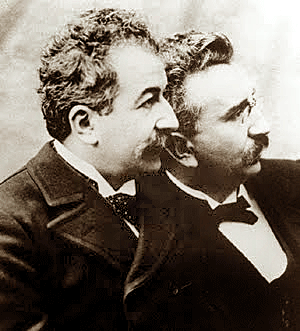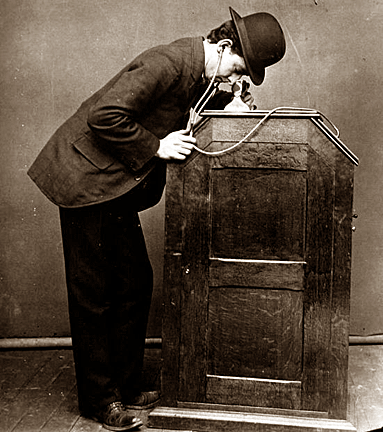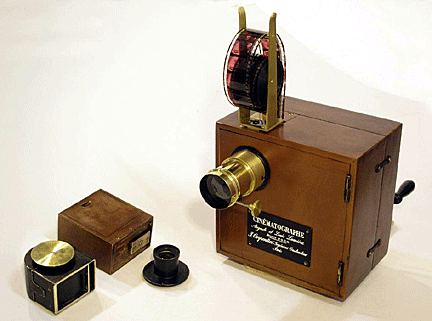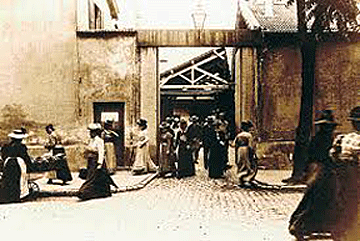 Today’s
projected movies can be traced back to two brothers from Lyon,
France, Louis and Auguste Lumiere. As French inventors, they
pioneered an early motion picture camera and projectot called the
Cinématographe, from which came the word cinema.
Today’s
projected movies can be traced back to two brothers from Lyon,
France, Louis and Auguste Lumiere. As French inventors, they
pioneered an early motion picture camera and projectot called the
Cinématographe, from which came the word cinema.
Originally, Louis worked with his father, Antoine, in their
photographic equipment manufacturing business. In 1881, 17-year-old
Louis invented a new “dry plate” process of developing film, which
boosted his father’s business enough to fuel the opening of a new
factory in the Lyons suburbs. By 1894, the Lumières were producing
some 15 million plates a year.
 That
year, Antoine Lumière attended an exhibition of Edison’s Kinetoscope
in Paris. Upon his return to Lyons, he showed his sons a length of
film he had received from one of Edison’s concessionaires; he also
told them they should try to develop a cheaper alternative to the
peephole film-viewing device and its bulky camera counterpart, the
Kinetograph. While the Kinetoscope could only show a motion picture
to one individual viewer, Antoine urged Auguste and Louis to work on
a way to project film onto a screen, where many people could view it
at the same time.
That
year, Antoine Lumière attended an exhibition of Edison’s Kinetoscope
in Paris. Upon his return to Lyons, he showed his sons a length of
film he had received from one of Edison’s concessionaires; he also
told them they should try to develop a cheaper alternative to the
peephole film-viewing device and its bulky camera counterpart, the
Kinetograph. While the Kinetoscope could only show a motion picture
to one individual viewer, Antoine urged Auguste and Louis to work on
a way to project film onto a screen, where many people could view it
at the same time.
Auguste began the first experiments in the winter of 1894, and by
early the following year the brothers had come up with their own
device, which they called the Cinématographe. Much smaller and
lighter than the Kinetograph, it weighed around 11 pounds and
operated with the use of a hand-powered crank. The Cinématographe
photographed and projected film at a speed of 16 frames per second,
much slower than Edison’s device which recorded images at 48 frames
per second. This meant it was less noisy to operate and used less
film.
The Lumieres patented several significant processes leading up to
their film camera, most notably film perforations, originally
invented by Emile Reynaud, as a means of advancing the film through
the camera and projector. The original cinématographe had been
patented by Léon Guillaume Bouly on February 12, 1892.
 The
key innovation at the heart of the Cinématographe was the film
transport mechanism. Two pins or claws, inserted into the sprocket
holes, punched into the celluloid film strip. The pins moved the
film along and then retracted, leaving the film stationary during
exposure. Louis Lumière designed this process of intermittent
movement based on the way in which a sewing machine worked, a tactic
that Edison had considered but rejected in favor of continuous
movement.
The
key innovation at the heart of the Cinématographe was the film
transport mechanism. Two pins or claws, inserted into the sprocket
holes, punched into the celluloid film strip. The pins moved the
film along and then retracted, leaving the film stationary during
exposure. Louis Lumière designed this process of intermittent
movement based on the way in which a sewing machine worked, a tactic
that Edison had considered but rejected in favor of continuous
movement.
A three-in-one device that could record, develop and project motion
pictures, the Cinématographe became the first viable film camera.
Using it, the Lumière brothers shot footage of workers at their
factory leaving at the end of the day on March 19, 1895. They showed
the resulting film, “La Sortie des ouvriers de l’usine Lumière,” or
“Workers Leaving the Lumière Factory,” on March 22, 1895 at the
"Society for the Development of the National Industry" in Paris to
an audience of 200 people, one of whom was Léon Gaumont, then
director of the company the Comptoir géneral de la photographie.
Louis Lumiere’s main focus at the conference was the recent
developments in still color photography. But much to his surprise,
the moving black and white images from his film projector got more
attention than his colored stills.

After a number of other private screenings, the Lumière brothers
unveiled the Cinématographe in their first public screening on
December 28, 1895, at the Salon Indien du Grand Cafe on Paris’
Boulevard de Capuchines. for about 40 paying visitors and invited
relations which has been traditionally regarded as the birth of
cinema.
 This
history-making presentation consisted of 10 short films. The first,
La Sortie de l'usine Lumière à Lyon—literally, "The Exit from the
Lumière Factory in Lyon," lasted only 46 seconds. The longest, Le
Jardinier, The Gardener, and Les Forgerons, The Blacksmiths, ran for
only 49 seconds each while the shortest, Baignada en mer, Bathing in
the Sea, ran for 38 seconds.
This
history-making presentation consisted of 10 short films. The first,
La Sortie de l'usine Lumière à Lyon—literally, "The Exit from the
Lumière Factory in Lyon," lasted only 46 seconds. The longest, Le
Jardinier, The Gardener, and Les Forgerons, The Blacksmiths, ran for
only 49 seconds each while the shortest, Baignada en mer, Bathing in
the Sea, ran for 38 seconds.
In early 1896, they
opened Cinématographe theaters in London, Brussels, Belgium and New
York, as well as visiting Bombay, Montreal, and Buenos Aires. After
making more than 40 films that year, mostly scenes of everyday
French life, but also the first newsreel of the French Photographic
Society conference and the first documentaries about the Lyon Fire
Department, they began sending other cameramen-projectionists out
into the world to record scenes of life and showcase their
invention.
 The
moving images had an immediate and significant influence on popular
culture with the film L'Arrivée d'un Train en Gare de la Ciotat—literally,
"The Arrival of a Train at La Ciotat," more commonly known as
“Arrival of a Train at a Station” and #Carmaux, Défournage du Coke,
or “Drawing out the Coke.” Many film historians believe these
actuality films, or actualités, to be the first, primitive
documentaries. They also made the first steps towards comedy film
with the slapstick of “L'Arroseur Arrosé.”
The
moving images had an immediate and significant influence on popular
culture with the film L'Arrivée d'un Train en Gare de la Ciotat—literally,
"The Arrival of a Train at La Ciotat," more commonly known as
“Arrival of a Train at a Station” and #Carmaux, Défournage du Coke,
or “Drawing out the Coke.” Many film historians believe these
actuality films, or actualités, to be the first, primitive
documentaries. They also made the first steps towards comedy film
with the slapstick of “L'Arroseur Arrosé.”
However, the brothers
stated that "the cinema is an invention without any future" and
declined to sell their camera to other filmmakers such as Georges
Méliès., upsetting many early film makers.
By 1905, the Lumières had withdrawn from the moviemaking business in
favor of developing the first practical photographic color process,
known as the Lumière Autochrome.
